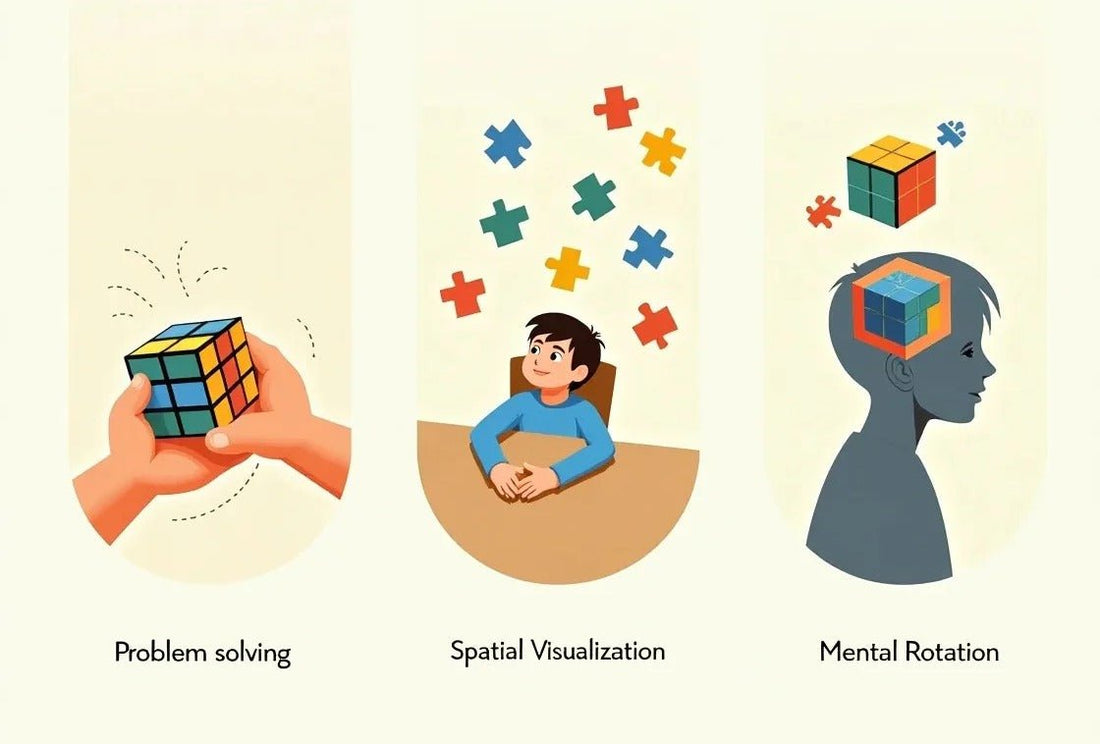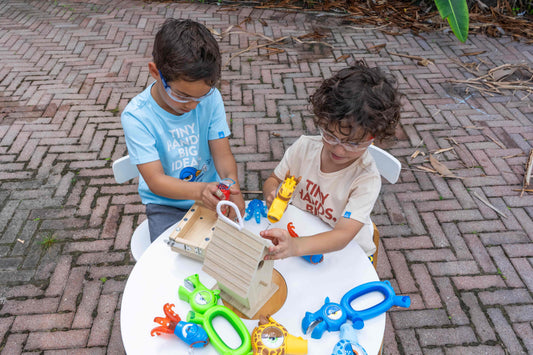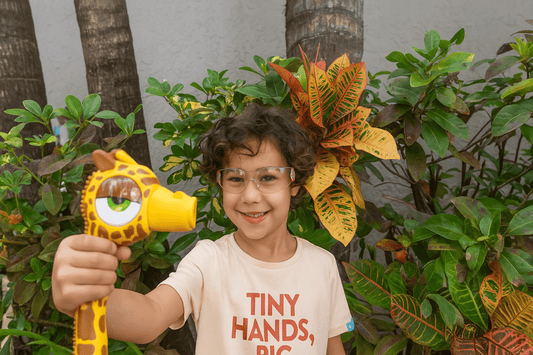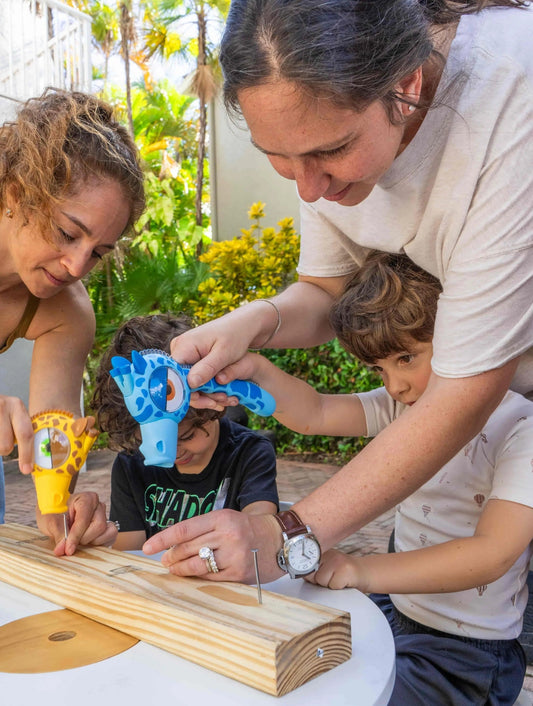
Parent’s Guide to Boosting Spatial Smarts Using Engineering Tools for Kids
Table of content
- 1. What Is Spatial Intelligence, Really?
- 2. Why Spatial Intelligence Is the Gateway to an Engineering Mindset
- 3. Signs Your Kid Might Already Be Wired Like an Engineer
- 4. How DIY Projects Build Spatial Skills
- 5. DIY Projects by Age Group to Boost Spatial Intelligence Using Engineering Tools for kids
- 6. Encouraging Spatial Thinking at Home (Without Losing Your Mind)
- 7. It All Starts at Home
There are some moments when you start to wonder if your kid is a genius. Like when they build a rocket ship out of cereal boxes and call it “NASA but for dogs.” And then there are the moments you're... not too sure. Like when they try to flush your car keys because “the toilet needed treasure.” Either way, the truth is—kids are curious, unfiltered, and wonderfully unhinged in the best way possible. And honestly? That’s something to celebrate.
Because curiosity is fuel. And when your kid does something wildly out of the box, the best thing you can do is lean in and give them more to explore. That’s where spatial intelligence starts to bloom especially with the right engineering tools for kids. Think of it as the brain's blueprint-drawing superpower, and it shows up everywhere: in engineering, architecture, robotics, animation, and yes even surgery.

And one of the best ways to help kids strengthen it? DIY projects. Whether it’s with engineering toys, hands-on crafts, or creative kids toys, building things taps into real-world problem-solving and brain development.
This guide is all about helping you channel that glorious chaos into something powerful: spatial intelligence. We'll walk through what it is, why it matters for your child’s brain development and confidence, and how fun DIY projects (with the right engineering tools for kids) can lay the groundwork for real-world skills in engineering, design, and beyond.
What Is Spatial Intelligence, Really?
Let’s not overcomplicate this, but there are a few things that matter when it comes to nurturing your child. And spatial intelligence? That one deserves some spotlight.
In simple terms, it’s your brain’s ability to visualize, move, and manipulate things in space. Like when your kid figures out how to cram eight oddly shaped toys into one tiny backpack and still finds room for a cookie. That’s spatial thinking.
The cool part? It can be built at any age. But it’s way easier when you’re young and your brain’s still firing off wild, imaginative ideas 24/7. We adults? We've got grocery lists, emails, and the vague memory of where we left our car keys competing for brain space. So the next time you’re building something with your kid, think of yourself as a contributor, not a teacher. You’re not lecturing—you’re creating side by side. Who knows you might find engineering tools for kids useful for you as well.
Howard Gardner, the guy behind the theory of multiple intelligences, says spatial intelligence is just as real and important as linguistic or logical smarts. It’s what lets someone pack a suitcase like a pro, solve a Rubik’s cube without rage-quitting, or look at a flat IKEA manual and somehow build a 3D bookshelf.

There are a few key skills at play:
- Mental rotation – picturing objects from different angles
- Spatial visualization – seeing how parts fit together
- Visual-motor integration – coordinating what you see with what your hands do
Kids with strong spatial skills often thrive in STEM fields because they can imagine, design, and build. Whether it’s coding a game or sketching out a bridge, they can see the solution before it’s built.
And you don’t need fancy setups to help your kid flex this muscle—just some engineering toys, creative kids toys, or even basic engineering tools for kids can get the gears turning in a big way.
Why Spatial Intelligence Is the Gateway to an Engineering Mindset
So we’ve already discovered that spatial intelligence helps kids mentally rotate objects, visualize outcomes, and track how pieces fit together. But let’s dig into why that matters and why it actually lays the groundwork for engineering thinking.
Because skills like mental rotation, visualizing outcomes, and understanding how parts fit together aren’t just cute brain quirks—they’re the foundation for real-world engineering. That kind of thinking is what helps people build skyscrapers, design bridges, or code an entire video game from scratch. It’s how an architect can “see” a building before a single brick is laid. It’s how a robotics designer plans where every gear and wire should go before even opening the toolkit.
It starts with play, but the process is surprisingly technical.
- Problem-solving: Spatial thinkers break problems into parts and try different layouts. It’s not just about “fixing”—it’s about testing patterns until something clicks.
- 3D modeling (mentally): Kids learn to hold objects in their head, spin them around mentally, and imagine alternate versions. That’s CAD-level thinking—just without the software.
- Understanding cause and effect: When a tower collapses, or a marble run fails, spatial kids start asking: “What if I move this here?” That’s not random—it’s iterative logic in action.
-
Creative iteration: Maybe the fort didn’t stand up. Maybe the track didn’t curve right. But the process of adjusting, rebuilding, and testing again? That’s where design thinking begins.
While it might just look like a heap of pillows, trial-and-error play is secretly training your kid’s brain to think like a systems designer. Personally, I find that kind of sneaky brilliance very satisfying. And yes, even building a pillow fort totally counts as early-stage structural engineering. Especially if there’s a roof and some sort of snack bar situation built with engineering tools for kids, of course.
Signs Your Kid Might Already Be Wired Like an Engineer
Your kid might already be in the early stages of engineering mode—and if you were the kind of kid who built stuff, fixed things, or tried to “upgrade” the family toaster, you’ll probably spot it right away. But even if you weren’t that kind of kid (no judgment—I was more of a glitter-and-glue type), there’s still a way to tell.
Here are a few signs your little one might already be wired like a future problem-solver-in-chief:
- They’re obsessed with puzzles, blocks, or anything they can stack, snap, or sort
- They take apart STEM toys to see how they work—and sometimes even put them back together
- They say things like “what if we made it this way?” or “I have a better idea” at least twice a day
- They love mazes, maps, or anything that needs navigation—Minecraft fans, I’m looking at you
- They notice patterns most adults miss (like why all the spoons fit except that one)

Spatial skills like solving puzzles, spotting patterns, or obsessively stacking random objects? It’s curiosity mixed with a bit of strategy, and it’s absolutely worth nurturing (without going full science fair mode). Because the second you turn their Lego masterpiece into a physics lecture? Boom—they’ll disappear faster than your phone charger does when you're already late.
What you can do is make sure there are tools around that match their vibe. A few open-ended engineering toys, hands-on challenges, or even real engineering tools for kids (the safe kind, don’t worry) can go a long way.
How DIY Projects Build Spatial Skills
So far, we’ve covered everything there is to know about spatial intelligence—what it means, why it matters, and how you can spot it in your kid. Now comes the fun part: how this actually works in real life and how you can do it easily. The answer? DIY. Yep, the messy, hands-on, glue-on-your-elbow kind.

A study published in Psychological Science found that kids who regularly play with puzzles, blocks, and buildable materials show measurable gains in spatial reasoning—especially when an adult is involved. Basically, the more your kid builds stuff with you around, the sharper those spatial skills get.
So here’s the good news: you don’t need fancy tools or some Pinterest-level craft room. These DIY projects challenge your kid’s brain without them even realizing it’s happening.
Different types of projects light up different parts of their thinking:
- Woodworking teaches measurement, planning, and precision (yes, even if it’s just hammering nails into a plank with you watching nervously)
- Robotics kits combine logical sequencing with physical construction—they’re solving a puzzle with gears and wires
- Lego engineering gives their visual-spatial brain a real workout, especially when they freestyle their own designs
- Blueprint-based crafts (like building a birdhouse or cardboard castle) teach how to follow steps and visualize outcomes
Along the way, kids get a crash course in trial and error. Things break, fall apart, or just don’t work like they thought. But instead of giving up, they tweak, rebuild, and try again—and that’s where the magic happens. That whole loop of “What went wrong? What can I do differently?” is what engineers, designers, and inventors live by.
If you’re wondering where to begin, or how to help that spark grow, a few engineering tools for kids can make a big difference.you don’t have to overthink it. Start small. Use what’s around. Or grab one of those curated DIY kits designed with engineering tools for kids and other brainy builds in mind. Whether it’s with engineering toys or everyday kids toys repurposed for building, it’s all about letting them experiment, create, and tinker their way into a smarter, more confident version of themselves.
DIY Projects by Age Group to Boost Spatial Intelligence Using Engineering Tools for kids
Not every DIY project fits every age—and that’s a good thing. The key is matching the tools to their stage, not just their age. Here’s a quick guide to what works best, and when.
Ages 3–5: Tiny Builders with Big Imaginations
At this stage, it’s all about play that looks like chaos but actually teaches a ton. Think large blocks, magnetic tiles, nesting puzzles, or even kinetic sand. When your kid is stacking, sorting, or building “castles” for action figures, they’re learning spatial awareness, hand-eye coordination, and early problem-solving. Just let them explore with engineering tools for kids—no instructions needed.
Ages 6–9: Curious Creators in the Making
Now we’re talking scissors, rulers, and cardboard empires. Kids in this range can follow basic steps, so things like build-your-own toy sets, simple model kits, and cardboard engineering projects hit the sweet spot. It’s the perfect time to sneak in spatial terms like “next to,” “under,” and “rotate.” Give them blueprints, and watch them figure it out their way.
Ages 10–13: Budding Problem Solvers
These kids are ready for projects with actual stakes—snap circuits, beginner woodworking, and basic robotics kits. They’ll measure, balance, and structure their designs, and probably ask why something works (or doesn’t). This is when they start thinking like engineers, not just tinkerers. This would be the perfect time to hand them some engineering tools for kids and assist them
Teens (14+): The Future Engineers
Here’s where the heavy hitters come in—Arduino kits, 3D printing, and advanced model building. Give them a little independence (and a few YouTube tutorials), and they’ll prototype entire systems. This is also a great time to introduce mentorships or group builds for deeper learning and creative collaboration.
Encouraging Spatial Thinking at Home (Without Losing Your Mind)
This doesn’t have to be a big panic moment—it’s a slow and fun process. The kind of skills we’ve talked about? They take time. And that’s okay, because good things usually do. So give yourself and your kid a little grace here. Your job isn’t to turn them into an engineer overnight—it’s just to create space, cheer them on, and hand them the right tools when needed.
Make it playful. Set up a treasure hunt using simple maps or challenge them to a timed jigsaw puzzle race. Or better yet, throw in a “no instructions allowed” building challenge using blocks or magnetic tiles and see what happens. Spatial thinking thrives when kids don’t even realize they’re practicing it.

Daily life offers plenty of mini-labs too. Let them measure ingredients while baking, help assemble that IKEA nightstand, or sketch their ideas before they dive into building. Even asking things like “What do you think will happen if we try this?” or “Can you show me how you’d build that differently?” goes a long way.
And please—be okay with mess, crooked tape, engineering tools for kids lying everywhere and the occasional furniture screw left over. That’s part of the learning curve. Some of the best STEM gifts under $50 aren’t high-tech or flashy—they’re the ones that let kids fail, try again, and succeed their way.
It All Starts at Home
There’s something really powerful about building side by side with your kid. Not just furniture or cardboard castles—but confidence, creativity, and the kind of spatial smarts that stick with them. With the right tools and some room to explore, these DIY moments become more than just weekend fun—they become building blocks for an engineering mindset. So let’s keep that spark going. Let’s build their skills, their curiosity, and maybe a few birdhouses while we’re at it—together.
Built for little hands with big ideas





 https://handyfamm.com
https://handyfamm.com